REAL SCIENCE: INNOVATIVE SCIENCE PROGRAMS HELP STUDENTS IDENTIFY AND SOLVE REAL-WORLD PROBLEMS
Creative educators are using cutting-edge edtech tools to develop innovative science programs that engage students in doing real-world, inquiry-based science. Students are weeding out local invasive species, designing solutions to improve the air quality at their school, overcoming language barriers to present STEM projects in competitions, and leading a program that uses the process of innovation to teach 21st-century soft skills. Through all of these initiatives and more, districts are developing the next generation of problem-solvers by keeping it real.
INVISIBLE TECHNOLOGY, VISIBLE RESULTS
PLACE-BASED EDUCATION
When students ask to give up recess time to continue work on a science project, you know something great is happening. And when that project is making an important contribution to preserving the local environment, that’s even better still. Students in Columbia (MO) Public Schools (CPS) have surpassed their goal of removing a million invasive bush honeysuckle plants, which are choking out native trees and taking over parks and forests throughout Missouri, from their town. It’s hard work, but students are understanding “the true impact of invasive species,” says Mike Szydlowski, K–12 Science Coordinator for the district. And it’s also high tech, as students are using drones and mapping software to chart their progress. On many different levels, Szydlowski says, the initiative “has been an incredible success.”
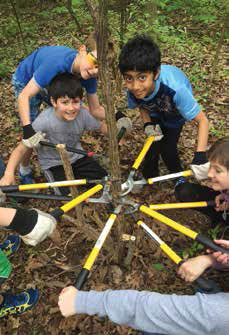
This project and others have grown out of the district’s focus on place-based education, “teaching standards in a way that emphasizes their importance to your ‘place’”—school, community, state. “The research around this area is quite compelling,” Szydlowski says, and it’s important for students “to see why what we’re learning is actually connected to our own community—not something far away.”
All CPS sixth graders go on a camping trip, where they learn science integrated with other subjects. And the district’s summer trip program, to Grand Teton National Park, has grown from 28 students to over 500. But while these kinds of trips give opportunities to engage with science in new ways, Szydlowski emphasizes the importance of the everyday work of learning and discovery in the classroom. An important component of that, he says, is “developing lessons that take students outside to learn a concept rather than reading about it in a book.”
TEACHERS, TESTS, AND INVISIBLE TECH
CPS students at Derby Ridge use a snowy day to learn about the albedo effect. But teaching outside the four walls of the classroom can also be risky, and Szydlowski emphasizes that teachers need to be allowed the professional freedom to try new things to address common standards—“even if they fail.”
Tools and ideas to transform education. Sign up below.
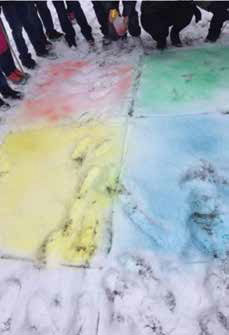
Teachers can learn from each other’s innovation and inspiration, and even from their failures, as they explore new ways to engage students. Teachers are under enormous pressure “to perform well on state tests, which do not always align with best teaching practices,” Szydlowski says. His hope is that tests will improve to “emphasize science practices more than memorizing facts.” The newer Next Generation Science Standards, he says, “are much more focused on engaging students on things that should matter to them. More practicing science and less memorizing science.”
The district is also working to make technology use “invisible”—an important distinction. “We’re working to make the technology work in ways that those outside of the classroom use it,” Szydlowski says. “We use technology for data collection, fast research, and communication. There are many free sources of real-time data that can be used in science to educate, analyze, and inform. We’ve been using a new book from the National Science Teachers Association, called Small Devices, Big Data, as inspiration for this movement.”
TOOLS THEY USE CPS
► Discovery Education Science Techbooks (middle school)
► ExploreLearning Gizmos
►iPads
►PhET Simulations
►Science A–Z (elementary)
►Vernier probeware
BUILDING LITERACY AND CONFIDENCE WITH ELLS THROUGH SCIENCE
How do you get ELLs engaged in science when basic words like theory, lab, and experiment aren’t yet part of their vocabulary? Many districts face this challenge, including San Elizario (TX) ISD (SEISD), where 51 percent of the nearly 4,000 students are coded LEP and over 95% are economically disadvantaged. But thanks to dedicated, well-trained teachers using strategies including GLAD (Guided Language Acquisition Design) and Interactive Word Walls (by Dr. Julie Jackson) and some innovative edtech tools, these students are rising above these statistics and engaging in an array of creative science projects that build skills, knowledge, and confidence.
INVENTIONS AND ELEVATOR PITCHES
An SEISD student presents a project to the judges at the district’s STEM Expo. Each year, elementary, middle, and high-school students at SEISD submit either an “Invention” (created using components that already exist) or an “Innovation” (created from scratch) at a STEM Expo. Students can work individually or in pairs or small groups. “Working in pairs or groups is particularly beneficial for ELLs,” says instructional officer Debbie Cortez, “because it allows them to speak and listen to English in a friendly, low-pressure environment. This hands-on, collaborative learning also makes academic vocabulary come to life.”
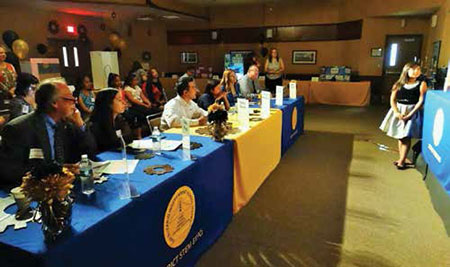
The winning students from each school then present their inventions at a districtwide competition with a three-to five-minute elevator pitch. Cortez says this experience helps ELLs “further develop and refine their English skills,” in addition to building confidence in a supportive, fun environment.
SEISD is also hoping to build on the success of last year’s inaugural district-wide STEM Tank competition for third through eighth graders. “The top 20 inventions at each campus qualified to attend our first annual STEM Camp,” which included workshops on robotics, biomedical science, and character education , says Cortez.
Other innovative programs at SEISD include a Mars Challenge for high-school students, who are working on Mars-survival projects, and an after-school STEM dolls group for fifth-and sixth-grade girls. Last year the girls engaged in weekly STEM activities, and this year they’re learning robotics and will be competing at the end of the school year.
STEMSCOPES AND THE 5ES
SEISD fifth- and sixth-grade STEMdolls group. Cortez says that “Accelerate Learning’s STEMscopes has really paved the way for our science instruction” (a Spanish version is also available for K–5). Units are developed around the constructivist 5E Instructional Model—Engage, Explore, Explain, Elaborate, and Evaluate—with additional modules for Intervention and Acceleration.
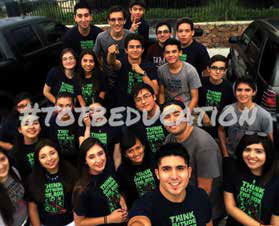
“The Explain and Elaborate phases are particularly helpful for ELLs,” says Cortez, and “students are now more willing to participate and take chances with vocabulary.” Students conduct inquiry-based science investigations in the Explore section, and during the Explain phase they collaborate in groups and use interactives to share their explanations of the Explore activities.
“In the Elaborate phase,” Cortez says, “students are challenged to extend their conceptual understanding and apply their skills through cross-curricular connections to reading, math, engineering, and other areas.” Engineering projects undertaken during the Elaborate phase promote scientific inquiry and literacy by giving students “the opportunity to apply what they’ve learned to real-world problems through group design projects. Students research, brainstorm, explore, build, test, and adjust.”
Both teachers and students feel very comfortable using STEMscopes, Cortez says, and many teachers also use the program 1:1, which gives them real-time assessment data to guide their instruction. All students in grades K–8 go through the Engineering Design Process (Ask, Imagine, Plan, Create, Improve) with at least three different activities every year using STEMscopes. Far from being simply classroom exercises, Cortez says that “students enjoy these projects so much that many showcase them at the STEM Expo.”
TOOLS THEY USE SEISD
► Accelerate Learning’s STEMscopes
► Chromebooks
► Edmodo
► iPads
► Nearpod
► Osmo
► Plickers
► Prezi
► Promethean boards
► QR Codes
► Recap
► Tellagami
FIGURING IT OUT AND MAKING IT REAL REAL
SCIENCE IN THE CLASSROOM
Third graders at Eastside Elementary work with Yamaha employees on their air quality project, planting trees around their school. Coweta County (GA) School System (CCSS) students are too busy figuring out why scientific phenomena happen, communicating their findings, and making evidence-based arguments to ask “Why do I have to learn this?” Science content specialist Donald White says the “goal is to make classroom science more like real science and engineering.” The new Georgia Standards of Excellence in science emphasize student engagement and practice so that they “figure out” rather than “learn about,” says White.
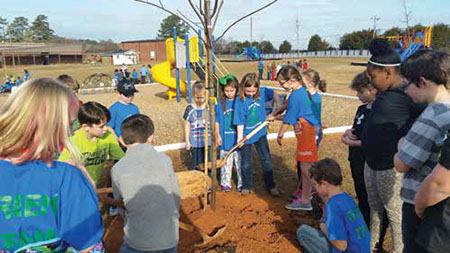
These student-scientists/engineers use real science and engineering tools for their investigations, like their new 1:1 Chromebooks paired with Labdiscs. The Labdiscs, White says, will allow them “to focus on data analysis rather than data processing” and “to make the connections between the data and the scientific concepts that much faster.”
REAL SCIENCE IN THE REAL WORLD
But CCSS students also have opportunities to design and implement solutions to real-world problems outside their classrooms, thanks to The Coweta STEM Institute (CSI), a collaboration between the district and the local business community. Yamaha Motor Manufacturing, for example, a large employer in the county, funded a student “handprinting” project. “Handprinting,” White explains, “is about leaving positive environmental impacts on the world.” Students at Eastside Elementary School identified air pollution as the problem they wanted to address. “They researched ways to improve air quality and designed some landscaping installations to help improve air quality,” White says. “They’re currently monitoring the air quality around their school using an air quality meter that measures particulates. Yamaha paid for the landscaping and the air quality meter. Their employees also supported the effort with their time.”
CCSS has also implemented a STEM Internship program, which gives eleventh-and twelfth-grade students “the opportunity to try on a career by working alongside people who are actually doing the job they want to do.” Student interns work in a variety of industries in the community.
White’s favorite story “is about a senior who wanted to be a civil engineer like his father and grandfather before him.” His internship involved working with a civil engineer for a few hours a day at the local water utility, helping to move sewer lines as part of a major road construction project. “As a result,” White says, “he decided he didn’t want to be a civil engineer.” While White was concerned that the “family tradition” had been broken, the family was grateful—the program saved their son from spending “two years at Georgia Tech to figure out that he didn’t want to be a civil engineer.” The student is now a successful environmental engineer.
TOOLS THEY USE CCSS
► Chromebooks
► Google Classroom
► Labdisc (currently evaluating)
WITH HARD WORK AND SOFT SKILLS, STUDENTS ARE AHEAD OF THE GAME
Chap Research founder Rachel Gardner gives the keynote at the CUE 2016 Fall Conference. Innovation, success, and leading-edge concept aside, Rachel Gardner’s story is an old one—a gifted, dedicated teacher-mentor invests time and trust in a student, and that student blossoms. In the next chapter of Gardner’s story, though, she passes her knowledge and leadership responsibilities on to other students. Gardner, now a freshman at Stanford University, laughs when she says that she’s now “just the founder” of Chap Research, an innovation program based at Westlake High School in Austin.

When Gardner’s robotics mentor Eric Rothfus asked her to design a prototype for The ChapR, a remote to control the robots they were building, he coached her through the entire innovation process—including product development, sales, and marketing. During the course of this year-long cycle she brought other students on board to work on the project as well. So far so good.
But once they had a prototype, Gardner had to step out of her comfort zone to do some guerilla marketing. “I was so shy, I hated it,” Gardner says, “but I knew I had to get the word out.” She did, and they shipped over 150 of the now-patented ChapRs (all profits from these sales went towards giving away free ChapRs to teams in need).
From this initial project, Chap Research, an after-school program that gives students opportunities to learn soft skills including teamwork, management, and public speaking, was born. Three years on, Chap Research students have completed 15 different projects and three research papers. From sales to soldering to creating a Web management platform and media campaigns, the students in the program drive every step of the process of taking a concept “from whiteboard to reality.”
It’s been a struggle, Gardner admits, to explain this entirely new concept. It’s more than a tech club, and it’s not entrepreneurship because it’s not focused on the product and its commercial potential. Rather, the Chap Research model centers on the process of innovation to learn these soft skills.
SOMETHING FROM NOTHING
Students in the program learn how to start from nothing and come up with something. It’s a skill, Gardner says, that not many students seem to bring to college classrooms. Students, and even employees in the workplace, are often lost when they don’t have a rubric and someone tells them, “Here’s the goal, no one’s done it before. Go!”
So Chap Research projects begin as brainstorming on a whiteboard. Mentors and veteran students then guide students to choose the best project ideas, form teams, outline proposals with necessary resources, and set reasonable and evenly spaced milestones. And every project, Gardner emphasizes, “needs to have a concrete deliverable”—whether that’s a product launch, a final prototype, a presentation, or a research paper. It’s an important validation, she says, of the time students invest—and it builds confidence as well.
The program’s cycle is generative and self-perpetuating in several respects. Every member of the program has to teach something they’ve learned—to solidify their own learning and to share the knowledge they’ve gained with a wider audience. As more experienced students take on leadership roles in the program, they learn the delicate interplay between leading, handholding, and letting go.
While Chap Research projects have been primarily tech-focused simply because of the interests of the students involved, Gardner would like to see it expand into other STEM areas as well.
PASSING IT ON
The excitement in Gardner’s voice is palpable when she talks about the growth exhibited by a student who entered the program uncomfortable with the fact that he had none of the programming knowledge that his friends did. Following in the footsteps of her own mentor, Gardner worked with him throughout the year, teaching him and slowly disengaging herself. She describes the experience as “a huge confidence boost” for the student, who’s now working as a lead on yet another project. And Gardner, the girl who felt too shy to approach strangers a few short years ago, has now spoken to large groups of educators in different contexts and even gave the closing keynote at the CUE 2016 Fall Conference.
A program like Chap Research requires time, expertise, financial resources, space, and district support. Gardner encourages schools considering such a program to network and reach out to others. For example, she says, “there are lots of engineers who love to teach others what they’re doing.”
It’s also important to let go and let students run things. The nature of a student-led program in a four-year school is that the leadership is, much like the world of technology itself, constantly and rapidly changing. Junior Riya Aggarwal, Chap Research’s current CEO, is set to present at iPadPalooza this summer and is similarly accomplished and excited about new projects, including a game called ARbattles.
While their goal is to pilot the program in another school at some point, Gardner says they’re “still running an experiment,” working out a stable model for replication. In the meantime, Gardner and her team are available as a resource and hope that this concept, of teaching soft skills through the medium of STEM projects, will “be an inspiration for a shift in how we look at science education.”
To find out more, go to ChapResearch.com.
LESS TIME COUNTING MEANS MORE TIME INVESTIGATING
Students at Overfelt High School investigate the effect of several chemicals on yeast growth. Students at William C. Overfelt High School, part of the East Side Union (CA) High School District in San Jose, are using the latest technology to learn how chemicals affect their daily lives. Chemistry teacher Ann Shioji, a 2015 Vernier/NSTA Technology Award winner, has been using Vernier’s SpectroVis Plus visible light spectrophotometer to help students conduct research.
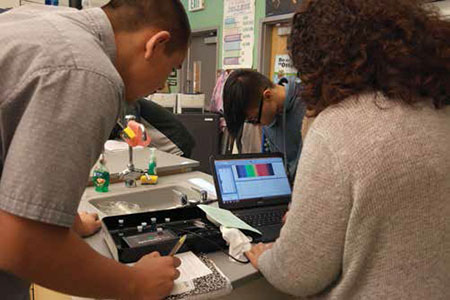
When Shioji first introduced a lesson on yeast in the fall of 2015, her students crafted their own creative experiments. They chose to investigate how fluorescent red light exposure affects yeast acceleration, how fast yeast grows in cold water, and how fructose corn syrup impacts yeast growth.
Because yeast is a single-celled organism, students can count it using serial dilutions and microscopes. And Shioji’s students have experience counting cells the old-fashioned way. But, says Shioji, “these methods are not as reliable as the in-situ experiments that the use of a SpectroVis Plus allows.” Reliability is one major advantage of using such a tool, but some of the other benefits include ease of use and speed. With the SpectroVis Plus, Shioji says, “students did not become inundated with procedures, but rather they were able to apply an experimental design efficiently.” The SpectroVis Plus also speeds up the data-collection process, allowing students to complete in a matter of minutes a lab that usually takes two days. Because of the tool’s speed and efficiency, students can use the data to develop deeper research questions.
LEARNING 21ST-CENTURY SKILLS WITH 21STCENTURY TECHNOLOGY
At the beginning of the lesson, students conduct preliminary research on the gestation period and respiration rates of yeast and perform a class investigation using the SpectroVis Plus to determine the rate of respiration of glucose by Saccharomyces to monitor a closed population of yeast. Students use serial data to understand spectroscopy techniques. Then they design their own inquiry-based experiments using SpectroVis Plus to measure how an independent variable of their choosing affects yeast growth. Students work in groups and present the best individual experiment to the class.
“When students had the opportunity to use this equipment, they were excited, engaged, and they rose to the challenge of designing and implementing their own rigorous experiments,” says Shioji. “They are practicing the skills necessary for the 21st century and using technology now that they’ll encounter in a college-level class.”
Shioji says her students are eager to conduct multiple trials to determine the effect of several chemicals on yeast growth. They also have a solid foundation to prepare for upcoming science fair competitions.
“When students are given the tools, they can compete on a higher level with students from all schools and all levels because they are provided with the technology necessary to explore their learning goals,” says Shioji.
For further resources, including a lesson plan for “Beauty and the Yeast,” go to www.vernier.com/company/success-stories/beauty-and-the-yeast/
PERFECT CIRCUITRY: CONNECTING TEACHERS WITH SUPPORT AND EDTECH RESOURCES
Sixth-grade PS/IS 217 students work on paper circuits and research information for their computing/biome projects. Posters are talking, circuit lights are blinking, and students are busy making, coding, and researching in Emily Wong’s sixth-grade science classroom at PS/IS 217 on Roosevelt Island (NYC). The students, as well the biomes they’re creating, are buzzing with energy.
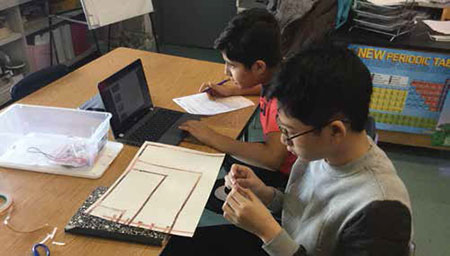
And suddenly the overarching goal, to “make sure every NYC student can build something digital that has meaning for them,” seems achievable. Cornell Tech, a graduate institution with a focus on creating pioneering leaders and technologies for the digital age, is setting out to help accomplish this goal through connecting teachers with the support and resources they need. They’re partnering with the NYC DOE, CSNYC, and more than a dozen schools, and their innovative Teacher-in-Residence (TIR) program is aligned to New York City’s Computer Science for All initiative (CS4All), a 10-year effort to train 5,000 teachers to teach CS.
Since the beginning of the 2016–17 school year, Meg Ray, a Cornell Tech Teacher-in-Residence, has been “providing content coaching, curriculum consultation, and professional development on a weekly basis for teachers in all grades” at PS/IS 217, where principal Mandana Beckman is committed to incorporating CS instruction into every classroom in grades K–8.
A TEACHER MODELS THE LEARNING PROCESS
“We have just started working with the middle school on CS integration in their science classes,” Ray says. “The goal is to deepen understanding of both subjects by building on prior CS experiences to support synthesis of new science content.” Ray sat down with science teacher Emily Wong in December, and they co-designed a computing project to complement her existing sixth-grade unit on ecosystems. Wong has never taught coding or CS, and Ray, a former classroom teacher herself, appreciates that Wong is “open to collaborating and modeling the learning process for her students.”
A screenshot of the type of Scratch program that PS/IS 217 sixth graders will create for their ecology unit. This project, a light-up, talking poster about biomes, combines “making with paper circuits, coding in Scratch, and physical computing with Makey Makey.” The students had attended community events held by Cornell Tech introducing making and paper circuits, so Ray knew that “bringing this type of hands-on work into the classroom would build on prior knowledge and be highly motivating.” The students feel at home with the technology and find the curriculum both “rigorous and fun.” As they build knowledge and confidence they’ll move on to more advanced projects, Ray says, such as “creating animations or programs that control robots” using Raspberry Pis and data collected with sensors.

Ray knows that “it can be intimidating to teach a new subject, especially one that involves learning brand-new content.” Teachers at PS/IS 217 are collaborating and applying pedagogy from other subjects to find the most effective ways to teach this new content. “Not many schools are incorporating computer science instruction to this degree yet,” Ray says, “so we’re iterating and debugging our lessons every day, just like we’re teaching the students to debug their code.”
A UNIVERSAL LANGUAGE
Ray recently witnessed the various strands of this work—CS learning, instruction, and collaboration—connect. Two ELLs and two native English speakers, placed in a group to work on the computing/biome project, were concerned about how they would work together. All four of these students, Ray says, “have been able to collaborate and contribute in meaningful ways. One reason is that electric circuits work the same way for everyone. Their language is universal.” Coding is similar. Although Scratch is based on English, “the code blocks also have distinct shapes and colors that can give students cues.” They’re also able to access tools like Google Translate on the computer they have on hand for the project “to communicate and access the same information about their research topic in their own primary languages,” Ray says. And so the energy for learning, in this classroom and many others throughout the city, continues to flow.
TOOLS THEY USE PS 217
► Chromebooks
► Code & Go Robot Mouse
► Dash & Dot Robots
► Document cameras
► iPads
► Makey Makey
► Raspberry Pis
► Scratch
► Touchscreen boards
